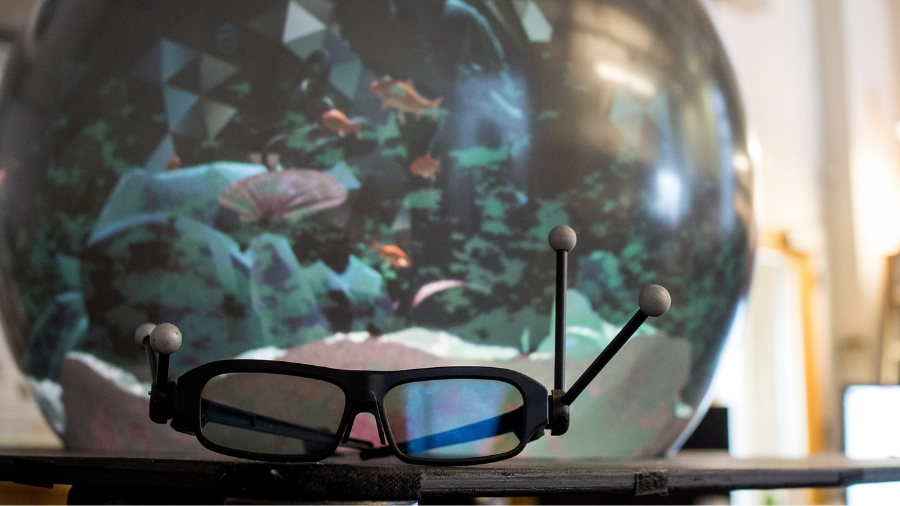Virtual reality needs spherical displays, say researchers
This 'crystal ball' could help encourage a more sociable virtual reality

Virtual reality is with us. It's real. It's here. But it's not exactly popular. Some think that's because we're social beings, and the idea of sitting on our own and being entertained alone and separated from others is off-putting.
Technically impressive they might be, but if the likes of HTC Vive Pro, Google Daydream View and the new Oculus Go merely allow us to spend more time with computer-generated characters, they're only ever going to have niche appeal. Besides, collaboration between players, and even two players seeing each other, is tricky without accurate avatars, which means using a lot of hardware.
Cue a ball-shaped VR display called Crystal that's designed to be watched by two people simultaneously, and uses relatively inexpensive off-the-shelf components. Could it replace VR headsets?
What is Crystal?
It's a mixed reality globe with a physical 24-inch hollow ball-shaped display that presents 3D virtual content, but overlaid on to the real world.
“The system supports perspective-corrected rendering in stereoscopic view for a single viewer, in mono for two viewers, and with additional mobile screens for extra viewers,” reads a paper published by researchers at the University of British Columbia and University of Saskatchewan.
“It integrates high precision multi-projector calibration, perceptual viewpoint calibration, high fidelity motion tracking and active flicker glasses to create a high frame rate, high resolution spherical display capable of presenting a multi-person mixed reality experience.” Put simply, each player gets their own perspective-corrected 3D experience.

How does Crystal work?
Crystal uses four carefully calibrated high-speed Optoma GT750ST mini short-throw projectors to create the images, which fill a plexiglass sphere coated with translucent projection paint. It uses advanced calibration and graphics rendering techniques to produce a complete, distortion-free 3D image even when viewed from multiple angles.
Sign up for breaking news, reviews, opinion, top tech deals, and more.
That calibration is done using an OptiTrack optical tracking headset, so don't think of this as a hardware-killing invention. "We track a person's head so that the image on there looks correct from their perspective as they move around," says Sidney Fels, an electrical and computer engineering professor at UBC. "Using that, the person sees a beautiful 3D scene as they move around."
That makes it viewable by more than one person, which makes it different to similar-looking 'fish tank virtual reality' (FTVR) displays that have existed for years and produce a stereo image of a 3D scene.

What does Crystal do?
Critically, it allows two people to see the created images. As well as encouraging a more sociable virtual reality that could be more interesting to people who like to play games with others rather than alone, it could also be useful for collaborating in the workplace.
“The resurgence of headset VR in recent years has renewed interest in collaborative VR experiences,” reads the paper. “Co-location within the physical world affords many tangible and intangible benefits for collaboration.”
Is Crystal any good?
The whole point of Crystal is 'shared 3D' viewing; it allows two people to have unobstructed 3D perspective views into a spherical display while still being able to see and talk to one another. "When you look at our globe, the 3D illusion is rich and correct from any angle," says Fels. "This allows two users to use the display to do some sort of collaborative task or enjoy a multiplayer game, while being in the same space. It's one of the very first spherical VR systems with this capability."
The researchers tested it over four day with multiple people cooperating in a ‘find the fish’ game, a 3D ping-pong game, and a cooperative apple-grabbing game. The players reported strong, believable 3D and motion parallax effects.

How could Crystal be used?
VR is not just about gaming. The researchers think their creation could be useful for teleconferencing and computer-aided design.
At CES 2019 in January, Belgian company Mimesys demoed a 5G-enabled holographic remote collaboration system with Intel using Magic Leap's mixed reality headsets (and also some awesome holographic business cards). It feels like you're in the room with someone, at least in a rudimentary way, because it overlays their image on to your surroundings.
Crystal is a similarly ambitious kind of mixed reality, and its makers have big plans. "Imagine a remote user joining a meeting of local users," says Ian Stavness, a computer science professor at the University of Saskatchewan and a member of the research team.
"At either location you can have a Crystal globe, which is great for seeing people's heads and faces in 3D, or you can have a team of industrial designers in a room, perfecting a design with the help of VR and motion tracking technology." To that end, Crystal also has a camera embedded in it.

What's next for Crystal?
This is just-out-of-the-lab technology, so don't expect to see it as a finished product anytime soon, but the researchers think that the two-player version of Crystal is just the beginning. They are now working on a four-person version, which would open up a lot more use-cases such as multiplayer VR gaming, virtual surgery and VR-aided learning.
“Headsets, and VR versions in particular, impede feelings of real-world connectedness and situatedness between people as they share a virtual space,” says the paper. “Of all mixed reality technologies under active research and development, we believe that spherical displays have the best potential to provide the visual illusion of a virtual scene merged indistinguishable with the real environment.”
So is it goodbye to VR headsets? "We're not saying that spherical VR will replace flat screens or headsets, but we think it can be a good option for VR activities where you still want to see and talk to other people," says Fels. "Be it at home or in the office, for work or play."
- Check out our guide to the best VR headsets

Jamie is a freelance tech, travel and space journalist based in the UK. He’s been writing regularly for Techradar since it was launched in 2008 and also writes regularly for Forbes, The Telegraph, the South China Morning Post, Sky & Telescope and the Sky At Night magazine as well as other Future titles T3, Digital Camera World, All About Space and Space.com. He also edits two of his own websites, TravGear.com and WhenIsTheNextEclipse.com that reflect his obsession with travel gear and solar eclipse travel. He is the author of A Stargazing Program For Beginners (Springer, 2015),